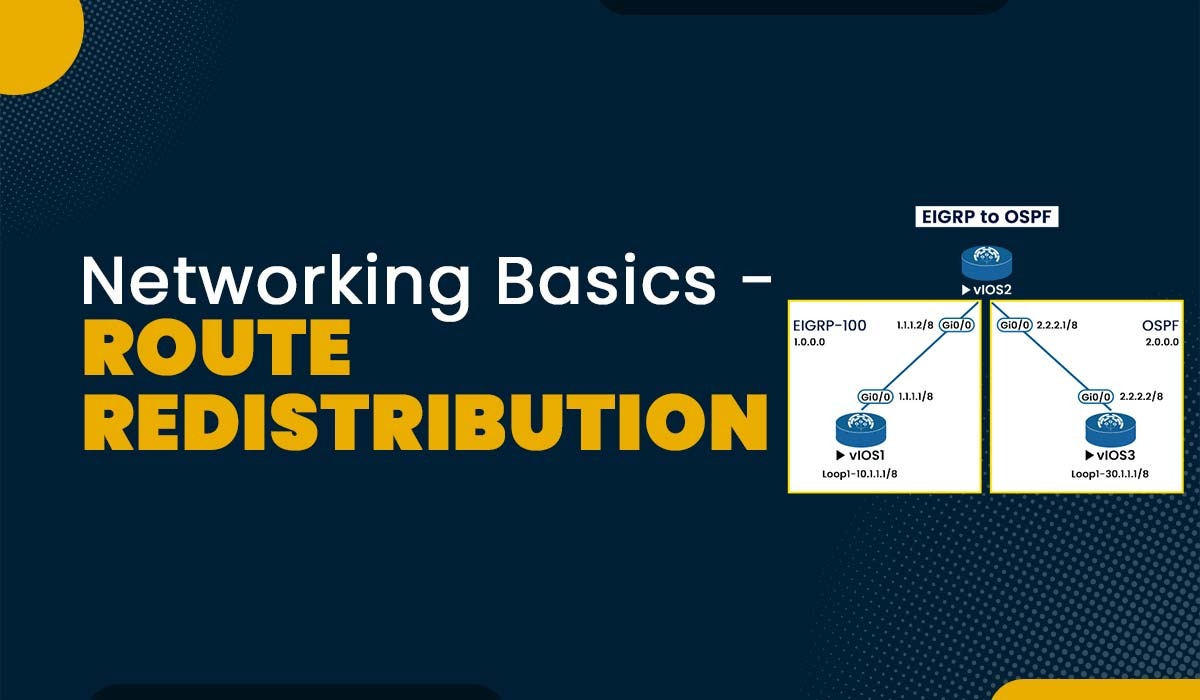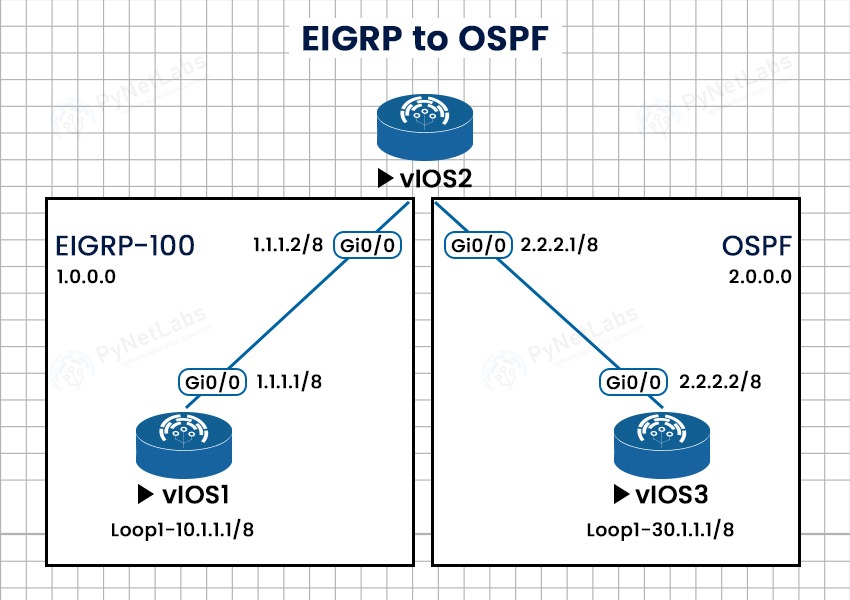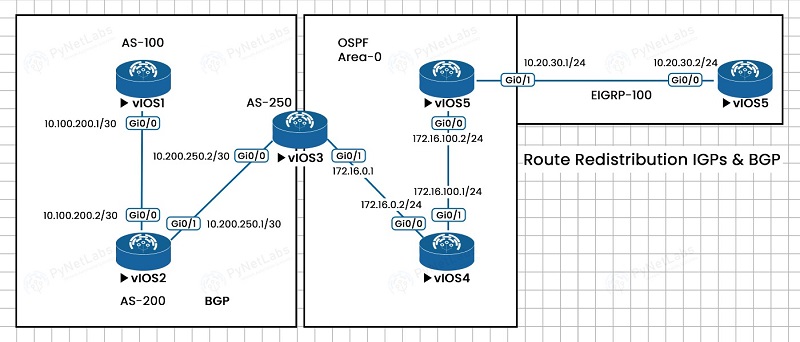What is Route Redistribution?

When two or more routing protocols share routing information, this is known as route redistribution in the networking world. Different routing protocols may be used in various parts of a network. The routers may discover and use all possible pathways to their destinations by redistributing routes amongst different protocols. Route Redistribution has always been an integral part of networking basics which you can learn from a CCNA Course. In this blog, we will go deep into the topic of routing redistribution from EIGRP to OSPF and vice versa. Also, the process of redistributing routes from IGP to BGP and vice versa. As the title indicates, this is a tutorial for learning the fundamentals of route redistribution. Routing is the process of determining the best and most effective path for network traffic to travel from its source to its destination across a network. It involves the selection and forwarding of data packets based on routing tables and algorithms implemented in network devices called Routers. The main objective of Routing is to transport data packets precisely and effectively while taking into account variables like network structure, available pathways, congestion, and routing metrics. For routers to communicate routing information and be able to decide how to forward packets, they employ routing protocols like OSPF, EIGRP, or BGP. Let’s understand the basic definition of Route redistribution now. Route Redistribution is the phenomena of two or more routing protocols sharing routing information. It is often used when connecting different networks that use different routing protocols, such as OSPF, EIGRP, or BGP. For example, suppose we have a network comprising two subnets: Subnet A and Subnet B. Subnet A uses OSPF as its routing protocol, while Subnet B uses EIGRP. If we want to allow Subnet A hosts to communicate with Subnet B hosts, we need to share the routing information between OSPF and EIGRP. This is where route redistribution comes in. The most usual situation for large business networks with several routers is to run a single IGP routing protocol (IGP = inner gateway protocol) between the routers to share the network’s routing information. OSPF, EIGRP (cisco proprietary), and, in certain situations, IS-IS are the most widely accepted IGP routing protocols used by today’s networks. RIP is also an IGP, although it is no longer utilized. It can only be found on old legacy networks (or in lab settings for research purposes). The scenario, as mentioned above, wherein a singular routing protocol is utilized, is a common case. In certain cases, multiple IGPs may be utilized within a network due to various factors, including but not limited to the combination of two organizations with distinct routing protocols, transitioning from one protocol to another, or the installation of router devices from a different vendor. In a network where two IGP routing protocols, such as enhanced interior gateway routing protocol (EIGRP) or open shortest path first (OSPF), coexist, routing redistribution is necessary to ease the exchange of routing information between the two protocols. Let’s further understand with the topology how the route redistribution process works. R-1 Router(config)#Hostname R-1 R-1(config)#int gig0/0 R-1(config-if)#ip add 1.1.1.1 255.0.0.0 R-1(config-if)#no shut R-1(config-if)#exit R-1(config)#int gig0/1 R-1(config-if)#ip add 10.1.1.1 255.0.0.0 R-1(config-if)#no shut R-1(config-if)#exit R-2 Router(config)#Hostname R-2 R-2(config)#int gig0/0 R-2(config-if)#ip add 1.1.1.2 255.0.0.0 R-2(config-if)#no shut R-2(config-if)#exit R-2(config)#int gig0/1 R-2(config-if)#ip add 2.2.2.1 255.0.0.0 R-2(config-if)#no shut R-2(config-if)#exit R-3 Router(config)#Hostname R-3 R-3(config)#int gig0/0 R-3(config-if)#ip add 2.2.2.2 255.0.0.0 R-3(config-if)#no shut R-3(config-if)#exit R-3(config)#int gig0/1 R-3(config-if)#ip add 30.1.1.1 255.0.0.0 R-3(config-if)#no shut R-3(config-if)#exit Routing for R-1 R-1(config)#router eigrp 100 R-1(config-router)#network 10.0.0.0 R-1(config-router)#network 1.0.0.0 R-1(config-router)#exit Routing for R-2 R-2(config)#router eigrp 100 R-2(config-router)#network 1.0.0.0 R-2(config-router)#exit *Feb 22 10:20:43.951: %DUAL-5-NBRCHANGE: EIGRP-IPv4 100: Neighbour 1.1.1.1 (GigabitEthernet0/0) is up: new adjacency R-2(config)#router ospf 1 R-2(config-router)#network 2.0.0.0 0.255.255.255 area 0 R-2(config-router)#ex Routing for R-3 R-3(config)#router ospf 1 R-3(config-router)#network 30.0.0.0 0.255.255.255 area 0 R-3(config-router)#network 2.0.0.0 0.255.255.255 area 0 R-3(config-router)#ex *Feb 22 10:22:56.159: %OSPF-5-ADJCHG: Process 1, Nbr 2.2.2.1 on GigabitEthernet0/0 from LOADING to FULL, Loading Done R-2(config-router)#router eigrp 100 R-2(config-router)#redistribute ospf 1 metric ? <1-4294967295> Bandwidth metric in Kbits per second R-2(config-router)#redistribute ospf 1 metric 10000 ? <0-4294967295> EIGRP delay metric, in 10 microsecond units R-2(config-router)#redistribute ospf 1 metric 10000 100 ? <0-255> EIGRP reliability metric where 255 is 100% reliable R-2(config-router)#redistribute ospf 1 metric 10000 100 255 ? <1-255> EIGRPEffective bandwidth metric (Loading) where 255 is 100% loaded R-2(config-router)#redistribute ospf 1 metric 10000 100 255 1 ? <1-65535> EIGRP MTU of the path R-2(config-router)#redistribute ospf 1 metric 10000 100 255 1 1500 R-2(config-router)#exit R-2(config)#router ospf 1 R-2(config-router)#redistribute eigrp 100 subnets R-2(config-router)#exit Routing Table for R-1 As OSPF Routes are injected here mentioned as external EIGRP with AD of 170 Routing info. For R-1 As you can now see the redistributed routes coming from EIGRP are mentioned here in the OSPF domain by O E2 routes. So, that‘s the one scenario for IGP redistribution but now we’ll try to redistribute IGPs & BGP together in a single lab. Initially, we’ll start with the basic IP configuration & then we’ll perform routing as mentioned according to the topology! BGP Process on – (R1, R2, R3) OSPF Process on – (R3, R4, R5) EIGRP Process on – (R5, R6) R-1 R-1(config)#int gig0/0 R-1(config-if)#ip add 10.100.200.1 255.255.255.252 R-1(config-if)#no shut R-1(config-if)#exit R-2 Router(config)#hostname R-2 R-2(config)#inter gig0/0 R-2(config-if)#ip add 10.100.200.2 255.255.255.252 R-2(config-if)#no shu R-2(config-if)#ex R-2(config)#int gig0/1 R-2(config-if)#ip add 10.200.250.1 255.255.255.252 R-2(config-if)#no shut R-2(config-if)#exit R-3 Router(config)#hostname R-3 R-3(config)#int gig0/0 R-3(config-if)#ip add 10.200.250.2 255.255.255.252 R-3(config-if)#no shut *Feb 22 10:45:06.551: %LINK-3-UPDOWN: Interface GigabitEthernet0/0, changed state to up *Feb 22 10:45:07.551: %LINEPROTO-5-UPDOWN: Line protocol on Interface GigabitEthernet0/0, changed state to up R-3(config-if)#int gig0/1 R-3(config-if)#ip add 172.16.0.1 255.255.255.0 R-3(config-if)#no shut R-3(config-if)#exit R-4 R-4(config)#int gig0/0 R-4(config-if)#ip add 172.16.0.2 255.255.255.0 R-4(config-if)#no shut R-4(config-if)#exit *Feb 22 10:46:25.289: %LINK-3-UPDOWN: Interface GigabitEthernet0/0, changed state to up *Feb 22 10:46:26.293: %LINEPROTO-5-UPDOWN: Line protocol on Interface GigabitEthernet0/0, changed state to up R-4(config)#int gig0/1 R-4(config-if)#ip add 172.16.100.1 255.255.255.0 R-4(config-if)#no shut R-5 R-5(config)#int gig0/0 R-5(config-if)#ip add 172.16.100.2 255.255.255.0 R-5(config-if)#no shut R-5(config-if)#exit R-5(config)#inter gig0/1 R-5(config-if)#ip add 10.20.30.1 255.255.255.0 R-5(config-if)#no shut R-5(config-if)#exit R-6 R-6(config)#hostname R-6 R-6(config)#int gig0/0 R-6(config-if)#ip add 10.20.30.2 255.255.255.0 R-6(config-if)#no shut Now, we’ll implement routing according to routers! R-1 R-1(config)#router bgp 100 R-1(config-router)#neighbor 10.100.200.2 remote-as 200 R-1(config-router)#exit *Feb 22 10:50:34.361: %BGP-5-ADJCHANGE: neighbor 10.100.200.2 Up R-2 R-2(config)#router bgp 200 R-2(config-router)#neighbor 10.100.200.1 remote-as 100 *Feb 22 10:50:31.767: %BGP-5-ADJCHANGE: neighbor 10.100.200.1 Up R-2(config-router)# R-2(config-router)#neighbor 10.200.250.2 remote-as 250 R-2(config-router)#network 10.100.200.0 mask 255.255.255.252 R-2(config-router)#exit *Feb 22 10:52:30.176: %BGP-5-ADJCHANGE: neighbor 10.200.250.2 Up R-3 R-3(config)#router ospf 1 R-3(config-router)#network 172.16.0.0 0.0.0.255 area 0 R-3(config-router)#exit R-3(config)#router bgp 250 R-3(config-router)#neighbor 10.200.250.1 remote-as 200 R-3(config-router)#network 10.200.250.0 mask 255.255.255.252 R-3(config-router)#exit *Feb 22 10:52:34.314: %BGP-5-ADJCHANGE: neighbor 10.200.250.1 Up R-4 R-4(config)#router ospf 1 R-4(config-router)#network 172.16.100.0 0.0.0.255 area 0 R-4(config-router)#network 172.16.0.0 0.0.0.255 area 0 R-4(config-router)#ex *Feb 22 10:58:23.768: %OSPF-5-ADJCHG: Process 1, Nbr 172.16.0.1 on GigabitEthernet0/0 from LOADING to FULL, Loading Done R-5 R-5(config)#router ospf 1 R-5(config-router)#network 172.16.100.0 0.0.0.255 area 0 R-5(config-router)#exit *Feb 22 10:59:08.409: %OSPF-5-ADJCHG: Process 1, Nbr 172.16.100.1 on GigabitEthernet0/0 from LOADING to FULL, Loading Done R-5(config)#router eigrp 100 R-5(config-router)#network 10.20.30.0 R-5(config-router)#exit *Feb 22 10:59:34.244: %DUAL-5-NBRCHANGE: EIGRP-IPv4 100: Neighbor 10.20.30.2 (GigabitEthernet0/1) is up: new adjacency Now, we’ll redistribute – OSPF to BGP & BGP to OSPF on – R-3 R-3(config)#router ospf 1 R-3(config-router)#redistribute bgp 250 R-3(config-router)#exit R-3(config)#router bgp 250 R-3(config-router)#redistribute ospf 1 R-3(config-router)#exit EIGRP to OSPF & OSPF to EIGRP R-5 R-5(config)#router eigrp 100 R-5(config-router)#redistribute ospf 1 metric 10000 1 255 1 1500 R-5(config-router)#exit R-5(config)#router ospf 1 R-5(config-router)#redistribute eigrp 100 R-5(config-router)#exit Hence, the protocol redistribution for routers is complete. Route redistribution is a process in computer networking where routing information is exchanged between different routing protocols. It allows the redistribution of routes learned from one routing protocol into another, enabling communication between networks that use different routing protocols. An example of route redistribution is when a network administrator wants to connect two networks that use different routing protocols, such as OSPF and EIGRP. To achieve connectivity, the administrator can configure route redistribution, allowing routes learned from OSPF to be shared with the EIGRP network and vice versa. Route leaking refers to the intentional or unintentional sharing of routes between different routing domains or virtual routing instances within the same routing domain. On the other hand, route redistribution is a deliberate process of exchanging routing information between different routing protocols, allowing routes learned from one protocol to be shared with another. Route advertisement is the process of informing neighbouring routers about a specific route’s existence. On the other hand, Redistribution facilitates the integration of multiple routing domains and enables routers to exchange routing information across different networks. Route redistribution is a useful but complex process that allows communication between different networks that use different routing protocols. It requires careful planning and configuration to avoid potential problems and ensure optimal performance. By following some basic principles and best practices, we can implement route redistribution successfully and efficiently. Route Redistribution related Courses are ENCOR 350-401 and ENARSI 300-410.Introduction
What is Routing?
What is Route Redistribution?
Route Redistribution of IGP Protocols
Route Redistribution of EIGRP to OSPF

Redistribution for R-2


Route Redistribution IGPs & BGP

Frequently Asked Questions
Q1 – What is route redistribution?
Q2 – What is an example of a route redistribution?
Q3 – What is route leaking vs route redistribution?
Q4 – What is the difference between route advertisement and route redistribution?
Conclusion







